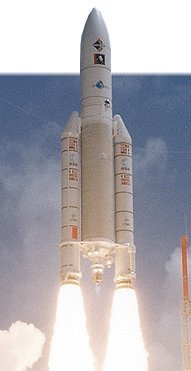So Long Ariane 4. Hellooooo Ariane 5
Arianespace's workhorse Ariane 4 wrapped up its career Saturday
with a picture-perfect mission -- placing its Intelsat 907 payload
into an accurate geostationary transfer orbit.
The early morning launch marked the final flight of an Ariane 4,
and the 116th mission of this launcher version -- which entered
service in 1988 and successfully orbited 158 primary payloads (plus
24 auxiliary payloads) with a combined mass of well over 400 metric
tons.

Following three days of postponements blamed on high-altitude
winds above the Spaceport, the historic mission took off at the
start of a one-hour launch window that opened at 4:00 a.m local
Kourou time.
As if in tribute to the Ariane 4's career-closing mission, the
weather cooperated by offering clear skies that allowed observers a
perfect view of the launcher's initial climbout. Observers could
clearly make out the separation of the four first-stage strap-on
boosters at approximately 2 minutes, 30 seconds into the
flight.
"The Ariane 4 program was an extraordinary technical achievement
and a truly excellent human venture," Arianespace Chief Executive
Officer Jean-Yves Le Gall said. "I want to personally thank all of
the team members at the French CNES space agency, the European
Space Agency, Arianespace, and the industrial participants in
Europe and French Guiana."
The first mission in 2003...and a new launch contract
Flight 159 was Arianespace's first mission of 2003, and will be
followed by four to five launches of the heavy-lift Ariane 5 -- the
next-generation successor to Ariane 4.
Le Gall also announced the company's first commercial launch
contract of 2003: the WildBlue 1 broadband satellite for WildBlue
Communications. WildBlue 1 is one of the first fully-dedicated
Ka-band satellites for consumer high-speed Internet service.
 Saturday morning's mission lofted the 23rd
Intelsat telecommunications payload orbited by Ariane, which was
the sixth Intelsat IX-series spacecraft carried by Ariane 4. Flight
159 was the 74th consecutive successful launch of an Ariane 4.
Saturday morning's mission lofted the 23rd
Intelsat telecommunications payload orbited by Ariane, which was
the sixth Intelsat IX-series spacecraft carried by Ariane 4. Flight
159 was the 74th consecutive successful launch of an Ariane 4.
Ariane 4 entered service in June 1988 as a follow-on to the
Ariane 1-3 vehicles, which paved the way for Arianespace's
leadership position in the commercial launch services market.
With its building-block design, Ariane 4 allowed a full range of
payloads to be lofted by a family of launchers - all sharing the
same basic design for streamlined operations, as well as a
standardized payload interface for customers.
Ariane 4: A "Two-Fer" Launch Vehicle
Ariane 4 enabled Arianespace to regularly pair up two satellite
payloads for shared dual missions - increasing the company's
competitiveness and enabling customers to share the mission
costs.
 This experience will be applied to the Ariane 5 -
with the new launcher's increased payload capability allowing even
larger payloads to be paired up on each mission.
This experience will be applied to the Ariane 5 -
with the new launcher's increased payload capability allowing even
larger payloads to be paired up on each mission.
For Saturday morning's final mission, Arianespace used an Ariane
44L version of Ariane 4 equipped with the four large liquid
strap-on boosters for additional thrust at liftoff and during
initial ascent. The total mass placed into orbit was an estimated
4,722 kg. (Intelsat 907 weighed in at approximately 4,680 kg.,
while the spacecraft interface adapter weighed 42.5 kg.).
Major participants in the Ariane 4 program included: EADS Launch
Vehicles (industrial lead contractor and prime for the first and
third stages); Astrium GmbH for the second stage and solid strap-on
boosters; Fiat-Avio and EADS Launch Vehicles for the solid
propellant strap-on boosters; Astrium France for the vehicle
equipment bay; Astrium UK for the SPELDA multiple payload
deployment system; and Contraves Space for the payload fairing.
During its operational lifetime, the all-time record for Ariane
4 was the 4,947 kg. mass orbited by an Ariane 44L in 1998 on Flight
113, which carried the AfriStar and GE-5 satellites.
Flight 159 was performed from the Spaceport's ELA-2 launch
complex, which has been the location of 119 Ariane liftoffs since
the facility entered service in 1986. Arianespace's mission
activity now shifts to the ELA-3 facility, which was built for
Ariane 5 launch operations.
Saturday's mission also marked a historic milestone for Intelsat
-- as its final Intelsat IX-series satellite was carried aboard the
Ariane 4.
 ANN's Daily Aero-Linx (04.15.24)
ANN's Daily Aero-Linx (04.15.24) Classic Aero-TV: 'No Other Options' -- The Israeli Air Force's Danny Shapira
Classic Aero-TV: 'No Other Options' -- The Israeli Air Force's Danny Shapira Aero-News: Quote of the Day (04.15.24)
Aero-News: Quote of the Day (04.15.24) Airborne 04.16.24: RV Update, Affordable Flying Expo, Diamond Lil
Airborne 04.16.24: RV Update, Affordable Flying Expo, Diamond Lil ANN's Daily Aero-Term (04.16.24): Chart Supplement US
ANN's Daily Aero-Term (04.16.24): Chart Supplement US





